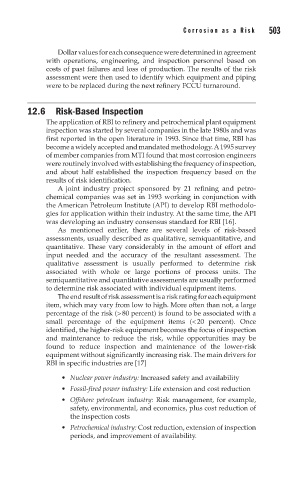Page 537 - Corrosion Engineering Principles and Practice
P. 537
502 C h a p t e r 1 2 C o r r o s i o n a s a R i s k 503
Dollar values for each consequence were determined in agreement
with operations, engineering, and inspection personnel based on
costs of past failures and loss of production. The results of the risk
assessment were then used to identify which equipment and piping
were to be replaced during the next refinery FCCU turnaround.
12.6 Risk-Based Inspection
The application of RBI to refinery and petrochemical plant equipment
inspection was started by several companies in the late 1980s and was
first reported in the open literature in 1993. Since that time, RBI has
become a widely accepted and mandated methodology. A 1995 survey
of member companies from MTI found that most corrosion engineers
were routinely involved with establishing the frequency of inspection,
and about half established the inspection frequency based on the
results of risk identification.
A joint industry project sponsored by 21 refining and petro-
chemical companies was set in 1993 working in conjunction with
the American Petroleum Institute (API) to develop RBI methodolo-
gies for application within their industry. At the same time, the API
was developing an industry consensus standard for RBI [16].
As mentioned earlier, there are several levels of risk-based
assessments, usually described as qualitative, semiquantitative, and
quantitative. These vary considerably in the amount of effort and
input needed and the accuracy of the resultant assessment. The
qualitative assessment is usually performed to determine risk
associated with whole or large portions of process units. The
semiquantitative and quantitative assessments are usually performed
to determine risk associated with individual equipment items.
The end result of risk assessment is a risk rating for each equipment
item, which may vary from low to high. More often than not, a large
percentage of the risk (> 80 percent) is found to be associated with a
small percentage of the equipment items (< 20 percent). Once
identified, the higher-risk equipment becomes the focus of inspection
and maintenance to reduce the risk, while opportunities may be
found to reduce inspection and maintenance of the lower-risk
equipment without significantly increasing risk. The main drivers for
RBI in specific industries are [17]
• Nuclear power industry: Increased safety and availability
• Fossil-fired power industry: Life extension and cost reduction
• Offshore petroleum industry: Risk management, for example,
safety, environmental, and economics, plus cost reduction of
the inspection costs
• Petrochemical industry: Cost reduction, extension of inspection
periods, and improvement of availability.

